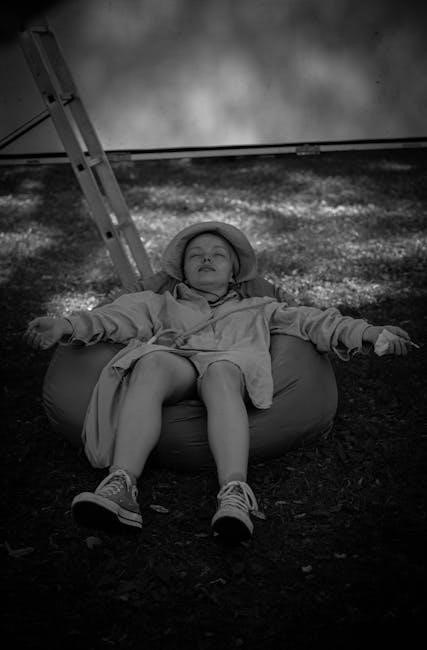Understanding sleeping bag temperature is crucial for outdoor enthusiasts, with ratings like T Comfort, T Limit and T Extreme, to ensure a safe and cozy sleeping experience in various conditions always matters.
Understanding Temperature Ratings
Temperature ratings are a crucial aspect of sleeping bags, as they determine the bag’s ability to keep the user warm in various conditions. The ratings are usually categorized into different levels, such as comfort, limit, and extreme. These levels indicate the temperature range in which the bag can provide adequate warmth. For example, a bag with a comfort rating of -20°C can keep the user warm in temperatures as low as -20°C. The limit rating, on the other hand, indicates the lowest temperature at which the bag can still provide some warmth, although it may not be enough for a comfortable night’s sleep. Understanding these ratings is essential for choosing the right sleeping bag for a particular outdoor activity or environment. By considering the temperature ratings, users can ensure they stay warm and safe during their outdoor adventures. This information is vital for making informed decisions when selecting a sleeping bag.
Types of Sleeping Bags and Temperature Ratings
Down, synthetic, and cotton sleeping bags have varying temperature ratings, affecting warmth and comfort in different conditions always and everywhere matters and is very important to consider.
Down Sleeping Bags and Their Temperature Limits
Down sleeping bags are known for their excellent insulation properties and are often used in cold weather conditions. The temperature limits of down sleeping bags can vary greatly, depending on factors such as the type of down used, the fill power, and the construction of the bag. Some down sleeping bags can have temperature ratings as low as -40°C, making them suitable for extreme cold weather conditions. However, it’s also important to consider the comfort temperature rating, which is typically higher than the limit temperature rating. For example, a down sleeping bag with a comfort temperature rating of -18°C may have a limit temperature rating of -40°C. This means that the bag can keep the user warm in temperatures as low as -18°C, but can still provide some protection in temperatures as low as -40°C. The EN rating system is often used to measure the temperature limits of down sleeping bags.

Factors Affecting Sleeping Bag Temperature Ratings
Factors like user metabolism, clothing, and sleeping pad affect temperature ratings and comfort levels always.
Importance of Comfort and Limit Ratings
The comfort and limit ratings are essential components of a sleeping bag’s temperature rating, as they provide users with a clear understanding of the bag’s performance in various conditions. The comfort rating indicates the temperature at which a user can expect to sleep comfortably, while the limit rating represents the lowest temperature at which the bag can keep a user safe. Understanding these ratings is crucial for outdoor enthusiasts, as it enables them to choose a sleeping bag that meets their specific needs. By considering both comfort and limit ratings, users can ensure a safe and enjoyable sleeping experience, even in extreme weather conditions. Additionally, these ratings can help users to better understand the overall performance of a sleeping bag, allowing them to make informed decisions when selecting a bag for their next adventure. This information is vital for a comfortable and safe outdoor experience.
EN Rating System for Sleeping Bags
European Norm rating system provides standardized temperature ratings for sleeping bags, ensuring accuracy and consistency in measurements and comparisons always matters and is very useful online.
EN Comfort and EN Limit Temperature Ratings
The EN rating system includes two key temperature ratings: EN Comfort and EN Limit. The EN Comfort rating represents the temperature at which a sleeping bag will keep an average person comfortable, typically defined as a temperature range that allows for a good night’s sleep. The EN Limit rating, on the other hand, represents the lowest temperature at which a sleeping bag will keep an average person alive, although it may not be comfortable. These ratings are determined through a series of tests and are designed to provide a standardized and accurate measure of a sleeping bag’s temperature performance. By considering both the EN Comfort and EN Limit ratings, outdoor enthusiasts can make informed decisions when selecting a sleeping bag for their needs. The EN rating system is widely used and respected in the outdoor industry, providing a reliable and consistent way to compare and evaluate sleeping bags.

Choosing the Right Sleeping Bag for Your Needs
Consider temperature ratings, fill type, and intended use when selecting a sleeping bag for optimal performance and comfort always matters in outdoor activities and trips every time.
Considering Temperature Ratings and Other Factors
To choose the right sleeping bag, consider temperature ratings, fill type, and intended use, as well as other factors such as weight, packed size, and durability, which affect the overall performance and comfort of the bag. The temperature rating is a key factor, as it determines the bag’s ability to keep you warm in different conditions. Other factors, such as the type of insulation, waterproofness, and breathability, also play a crucial role in ensuring a comfortable and safe sleeping experience. Additionally, consider the activities you will be doing, such as hiking or camping, and the climate you will be in, to determine the best sleeping bag for your needs. By considering these factors, you can select a sleeping bag that meets your specific requirements and provides optimal performance and comfort. This will help you to have a good night’s sleep and be ready for the next day’s activities.

Manufacturer Guidelines for Sleeping Bag Temperature Ratings
Snugpak and Marmot provide temperature rating guidelines based on experience and customer feedback always.
Snugpak and Marmot Temperature Rating Recommendations
Snugpak and Marmot are renowned manufacturers of high-quality sleeping bags, and their temperature rating recommendations are highly regarded in the outdoor industry. Snugpak’s temperature rating system is based on over 40 years of experience and customer feedback, ensuring that their products meet the needs of outdoor enthusiasts. Marmot, on the other hand, recommends temperature ratings based on the specific design and features of their sleeping bags. For example, Marmot’s extreme rating is somewhere around -40ºC, while their comfort rating is around -18ºC. These recommendations are crucial in helping consumers choose the right sleeping bag for their needs, and both Snugpak and Marmot provide detailed guidelines to ensure that their products are used safely and effectively. By following these recommendations, outdoor enthusiasts can enjoy a comfortable and safe sleeping experience in various conditions. This information is essential for making informed decisions when selecting a sleeping bag.

